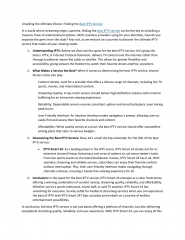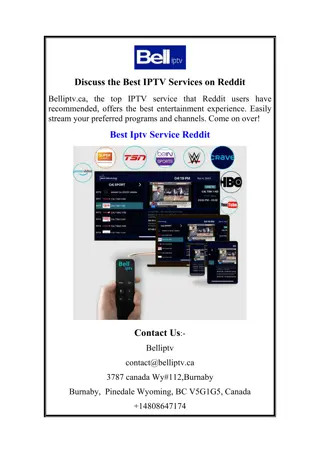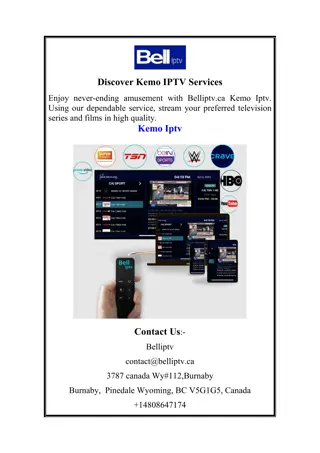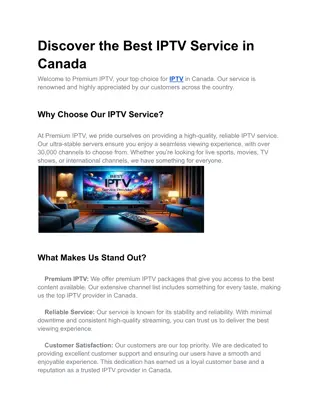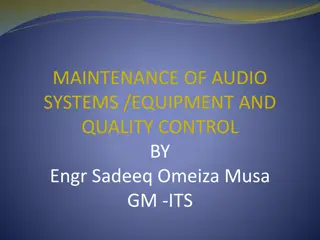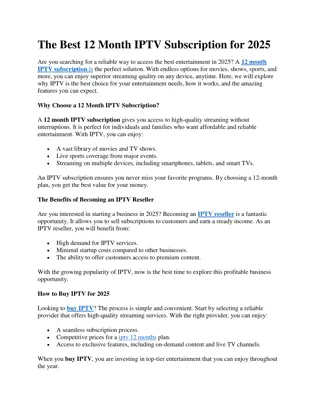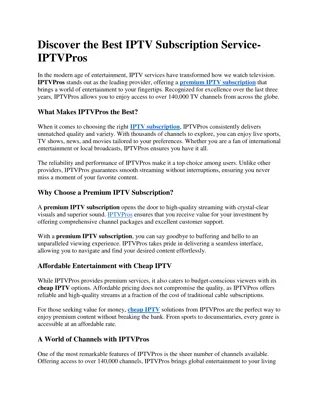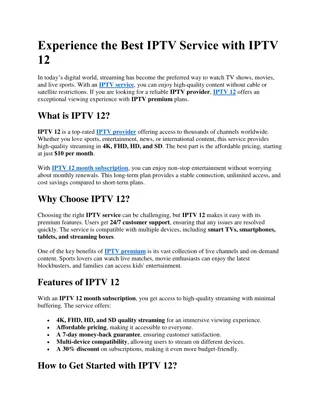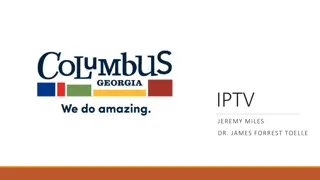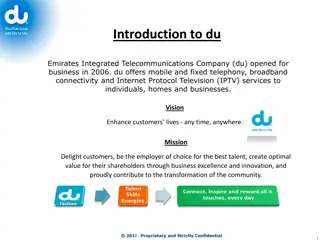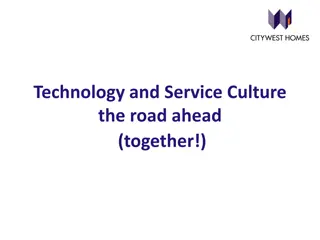
Evolution of IPTV: Services, Requirements, and Future Technologies
Explore the world of IPTV, a multimedia service delivering TV, video, audio, text, and more over IP networks. Discover its key components, technologies, security measures, and the promising future it holds. Gain insights into IPTV's network architecture and the shift towards more personalized, interactive, and high-quality viewing experiences.
Download Presentation

Please find below an Image/Link to download the presentation.
The content on the website is provided AS IS for your information and personal use only. It may not be sold, licensed, or shared on other websites without obtaining consent from the author. If you encounter any issues during the download, it is possible that the publisher has removed the file from their server.
You are allowed to download the files provided on this website for personal or commercial use, subject to the condition that they are used lawfully. All files are the property of their respective owners.
The content on the website is provided AS IS for your information and personal use only. It may not be sold, licensed, or shared on other websites without obtaining consent from the author.
E N D
Presentation Transcript
What is IPTV IPTV Services IPTV Requirements Network Architecture IPTV Components Key IPTV Technologies IPTV Security Future of IPTV
IPTV is defined as multimedia services such as television/video/audio/text/graphics/data delivered over IP based networks managed to provide the required level of quality of service and experience, security, interactivity and reliability. ITU focus group on IPTV Use Access Networks to reach clients, not general internet links IPTV is not audio/video through the internet
Internet TV IPTV Transport Use general internet Use dedicated, private network Geographical Reach Can be access from anywhere in the globe Limited by service provider Service quality Not guaranteed Guarantees high quality audio and video Set-Top-Box most of the time Access Mechanism A PC with media player Content Generation Use own content Provided by existing TV broadcasters
Basic and Premium Television Interactive TV / Two way communication HDTV Video on Demand Time shifted TV Instant Messaging TV Telephony Gaming and Betting on Demand Web and e-mail
More control over service for user What to watch and when to watch More interactive Better Quality DVD quality video, CD quality music Personalization Convergence Single device to watch TV, surf web and video calling PC is not attractive due to lower picture quality, cost and boot time
Factors helped the growth Digitization of content Development of compression techniques Growth in Broadband use Sri Lankan situation IPTV available for ADSL users
Content Production Content Aggregation Content Delivery Content Reproduction End User Program Production TV IPTV Service Providers TV Sets Stations IPTV Content Delivery: TV Head End IPTV Middleware VOD Systems Media Content Protection Systems (DRM) IP STB
Bandwidth for access link 4 Mbps per channel for SDTV HDTV: 20 Mbps per channel VoD: Quality of Experience (QoE) Step beyond QoS QoE Low downtime, maintenance intervals and channel change time QoS Low delay, jitter and packet loss
Bandwidth requirements for streaming High bandwidth continuously Last mile is the problem DSL originally employed for burst (web) traffic, Not support MPEG-2 Need to compress the video streams Reducing channel change time Due to multicasting it takes time Providing VoD Need to unicast messages
Regional Head End Home Network Access Network National Head End IP Core Network
MPEG-4 / H.264 RTSP RTP UDP TCP IP IGMP XDSL, Metro Ethernet, ATM
Acquiring video from different sources Video Encoding VoD delivering Content security Conditional Access System (CAS) Digital Rights Management (DRM) EPG Server OBSS Subscriber management system MPEG Encoder MPEG Encoder IPTV Delivery Network CAS DRM Media Streamer Live TV OBSS VoD Server
High speed data network Technologies used: ATM and SONET/SDH IP and MPLS Metro Ethernet
From IPTV Data Center to the subscriber 1.Fiber 2.DSL 3.Cable TV 4.Satellite 5.Wireless Broadband 6.Internet 11.00% 11.00% 2.00% 2.00% 22.00% 22.00% DSL Cable modem FTTH Other 65.00% 65.00%
Middleware A distributed operating system to connect IPTV components Runs on IPTV servers and IP-STBs Integrates with VOD system, Headend, CA/DRM, STB and the network End-to-end configuration User management Interactive services Provides channel/package and program together with pay TV solutions Links the electronic program guide (EPG) with the content Acts as a boot server for the STB and ensures that all STBs run compatible software
IPTV hardware and software infra-structure at customer premises Runs the IPTV middleware at client side Decrypt the scrambled video stream Video decoding Produce composite (analog) video output Program navigation with EPG PVR
User wants to watch TV channel User watches TV channel IP-STB connects to appropriate multicast group IP-STB recieves packets and encodes it IP-STB recieves packets, encodes it and sends to output device
Hardware drivers and media codec Operating system and network stack IPTV Client TCP/IP Stack TV browser Various plug-ins
CAS protect the content from illegal use CAS TV Signal ECM TV Set-Top Box (decryption) generator Multiplexer distribution network OBSS EMM generator Call Transaction data collector Smart card based CA system
DRM Protection against theft and piracy of digital media content Digital water marks REL Key DRM Client module Encryption Application generation
Channel change on IGMP IGMP LEAVE Green TV Content User Node A Node B IGMP JOIN Red TV Content User Node A Node B TV Content User Node A Node B
Video Encoding Improvement in compression to reduce BW requirement
TV set become a all in one box Replace the PC for entertainment (Limit it for programming, documenting) Everything (e-mail reading, FB, answering calls) from TV remote controller


